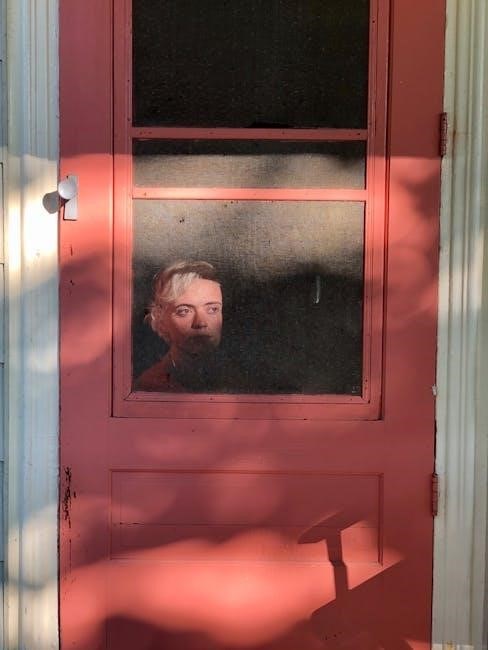Set in a mythical northern Maine town, Almost, Maine unfolds on a cold, starry winter night under the enchanting northern lights.
This romantic comedy explores love, loss, and second chances through magical realism and heartfelt moments, capturing the essence of human connection in a remote setting.
Overview of the Play
Almost, Maine is a romantic comedy composed of nine short, interconnected scenes, each highlighting a unique story of love, loss, and second chances in a mythical town.
Set on a cold, clear winter night under the magical glow of the northern lights, the play captures the essence of human relationships in a remote, enchanting setting.
Through a series of humorous and heartfelt moments, the characters navigate love’s complexities, often discovering unexpected truths about themselves and those around them;
The play’s structure allows for a diverse cast of characters, with roles ranging from lifelong friends to strangers brought together by fate.
Its blend of humor, emotional depth, and magical realism makes Almost, Maine a timeless exploration of love in all its forms.
Setting: A Mythical Town in Northern Maine
The play is set in a fictional town called Almost, Maine, located in the remote and picturesque Aroostook County, far from the coast and close to Canada.
This mythical setting, inspired by real northern Maine towns like Presque Isle, captures the essence of a cold, winter night under the breathtaking northern lights.

The town’s isolation and natural beauty create a magical backdrop for the stories, blending realism with a touch of fantasy.
The clear, star-filled sky and the northern lights serve as a symbolic and visually stunning setting, enhancing the emotional depth of the characters’ journeys.
While not a coastal town, Almost, Maine’s remote location emphasizes themes of love, loss, and redemption in a unique and enchanting environment.

Main Characters and Relationships
The play introduces a cast of characters exploring love, loss, and relationships in a magical, mythical town, emphasizing human connections and emotional journeys.
Pete and Ginette: Lifelong Friends
Pete and Ginette, lifelong friends, share a deep bond rooted in their adventures together in Almost, Maine. Their friendship is tested when Ginette reveals her romantic feelings, creating an awkward yet poignant moment. This scene highlights their emotional connection and the challenges of unspoken love, showcasing the complexity of their relationship. Their interaction underscores the play’s theme of love and vulnerability, as they navigate a turning point in their friendship. This moment is central to their character development and the overall narrative of the play, emphasizing the difficulty of expressing true emotions and the risk of losing a cherished connection. Their story resonates with audiences, illustrating the fragility and beauty of human relationships. The dynamic between Pete and Ginette is a cornerstone of the play’s exploration of love and loss. Their journey is both heartwarming and heartbreaking, leaving a lasting impact.
East and Glory: A Hiker and a Repairman
East, a rugged repairman, and Glory, a free-spirited hiker, form an unexpected connection in Almost, Maine. Their relationship blossoms quickly, with mutual attraction and shared moments of vulnerability. East’s practical nature contrasts with Glory’s adventurous spirit, creating a dynamic that explores themes of love and second chances. Their interactions are marked by a deep emotional understanding, highlighting the beauty of finding someone who truly sees you. The repairman’s role symbolizes mending hearts, while Glory’s journey represents self-discovery. Their story is a testament to the power of human connection in a remote, magical setting. The fast-paced development of their relationship adds a unique charm to the play, showcasing how love can emerge in the most unexpected ways. East and Glory’s story is a heartfelt reminder of the magic found in fleeting encounters and the enduring impact they can have on our lives.
Sandrine and Jimmy: A Misunderstanding
Sandrine and Jimmy’s story revolves around a poignant misunderstanding that highlights the complexities of communication in relationships. Sandrine, intent on expressing her feelings, gets a tattoo spelling “villian” instead of “villain,” symbolizing her emotional turmoil. Jimmy, noticing the mistake, gently points it out, leading to an awkward yet revealing moment. This scene showcases how miscommunication can both unite and isolate individuals, as they struggle to bridge the gap between their intentions and perceptions. The tension between them underscores the fragility of human connections, while also offering a glimmer of hope for understanding and reconciliation. Their interaction is a powerful exploration of how misunderstandings can reveal deeper truths about love, vulnerability, and the challenges of genuine communication. This subplot adds depth to the play’s overarching themes of love and loss, reminding audiences of the beauty in imperfect human interactions.
Gayle and Lendall: A Troubled Relationship
Gayle and Lendall’s relationship is marked by emotional turmoil and unmet expectations. In a poignant scene, Gayle demands that Lendall return the love she has given him, a request he struggles to understand. Her insistent pounding on the door and Lendall’s confusion highlight the imbalance in their relationship. This interaction underscores the pain of unreciprocated love and the difficulty of letting go. Their story serves as a reminder of how relationships can become complicated when emotions are not mutual or expressed clearly. The tension between them reflects the broader themes of love, loss, and the challenges of human connection. Gayle’s desperation and Lendall’s bewilderment create a powerful dynamic, illustrating how misunderstandings can deepen emotional wounds. Their troubled relationship adds depth to the play’s exploration of love and its many complexities.
Structure of the Play
Almost, Maine consists of nine short, interconnected scenes, each climaxing with a magical moment that explores themes of love, loss, and human connection in a remote setting.

Nine Short Scenes
Almost, Maine is structured as nine short, interconnected scenes, each with its own unique characters and storyline, set in the mythical town of Almost, Maine.

These scenes are woven together by the town’s magical atmosphere and the overarching theme of love and human connection. Each scene explores different facets of relationships, from lifelong friendships to chance encounters, and from heartbreak to hope.
The scenes are designed to stand alone but also contribute to the larger narrative of the town and its people. They feature a range of emotional moments, including misunderstandings, second chances, and unexpected revelations, all set against the backdrop of a cold winter night under the northern lights.
Through these vignettes, the play captures the complexity and beauty of human emotions, offering a touching and humorous exploration of love, loss, and redemption in a remote, almost-mythical setting.
Magical Moments in Each Scene
Each scene in Almost, Maine is punctuated by a unique magical moment that elevates the story beyond the ordinary, infusing it with a touch of wonder and enchantment.
These moments range from subtle, emotional epiphanies to more overtly fantastical events, such as the appearance of the northern lights or unexpected coincidences that shape the characters’ fates;
For instance, in one scene, the northern lights serve as a backdrop for a romantic encounter, while in another, a character’s heartfelt confession leads to an unexpected transformation in their relationship.
These magical elements not only enhance the play’s emotional depth but also underscore its central themes of love, loss, and redemption, creating a captivating experience for the audience.
Themes Explored in Almost, Maine
Themes of love, loss, and redemption are central, with characters navigating second chances and the complexities of human connection in a mystical setting.

Love and Loss
Love and loss intertwine poignantly in Almost, Maine, as characters navigate the complexities of romance, heartbreak, and longing under the magical northern lights.
From Pete and Ginette’s unspoken feelings to East and Glory’s mutual attraction, the play captures the fragility and beauty of love in its purest form.
Sandrine and Jimmy’s misunderstanding and Gayle’s demand for love’s return highlight the pain of loss and the struggle to hold onto connections.
The northern lights serve as a backdrop, symbolizing the fleeting nature of love and the deep emotional scars left by its absence.
Through these interconnected stories, the play explores how love can heal and hurt, often leaving characters—and audiences—reflecting on life’s bittersweet moments.
Second Chances
Almost, Maine poignantly explores the theme of second chances, offering characters opportunities to reconnect and rediscover love in unexpected ways.
Pete and Ginette, lifelong friends, confront unspoken feelings, while East and Glory experience mutual attraction, symbolizing fresh starts.
The northern lights create a magical backdrop, emphasizing the fleeting nature of such moments and the possibility of renewal.
Through these interconnected vignettes, the play highlights how second chances can heal past wounds and reignite hope, leaving a lasting impact on both characters and audiences.
The stories remind us that love, though fragile, can reemerge in the most unexpected ways, offering redemption and a chance to rewrite past mistakes.
This theme resonates deeply, making Almost, Maine a heartfelt exploration of human connection and the power of second opportunities.
Redemption and Forgiveness
Almost, Maine delves into the transformative power of redemption and forgiveness, weaving these themes through its interconnected stories.
Characters like Gayle and Lendall confront past hurts, seeking closure and understanding, while others, such as Pete and Ginette, navigate unspoken regrets.
The northern lights serve as a symbolic backdrop, representing cleansing and new beginnings, allowing characters to release burdens and find peace.
Through moments of vulnerability and honesty, the play illustrates how forgiveness can mend relationships and restore hope, even in the face of heartache.
Redemption in Almost, Maine is not about erasing mistakes but embracing them as part of the journey toward healing and growth.
This theme underscores the human capacity for compassion and the possibility of starting anew, leaving a profound impact on both characters and audiences.

Symbols and Metaphors
Symbols in Almost, Maine include the northern lights, representing transcendence and hope. The repairman symbolizes healing, while maps and directions metaphorically guide characters through life’s complex journeys and emotional landscapes.
Northern Lights as a Symbol

The northern lights in Almost, Maine serve as a powerful symbol, representing transcendence and hope. These celestial displays illuminate the night sky, creating a magical backdrop for the characters’ emotional journeys. The lights symbolize the extraordinary moments of connection and realization that occur in the story, often coinciding with acts of love, forgiveness, and self-discovery. Their fleeting beauty mirrors the temporary nature of human connections, emphasizing the importance of seizing moments of truth. The northern lights also evoke a sense of wonder and divine intervention, guiding characters toward second chances and redemption. This natural phenomenon becomes a metaphor for the elusive yet profound experiences of love and transformation, deeply intertwining the mystical with the mundane in the lives of Almost, Maine’s residents.
The Role of the Repairman
The repairman in Almost, Maine embodies a unique blend of practicality and mysticism. His character serves as both a literal and metaphorical fixer, mending broken objects while also indirectly aiding in the emotional repair of those around him. Through his interactions, he subtly guides characters toward self-reflection and healing. The repairman’s presence is often linked to moments of transformation, where characters confront past hurts or misunderstandings. His role underscores the theme of redemption, suggesting that even the most damaged relationships can be restored. The repairman’s enigmatic nature adds depth to the story, making him a catalyst for change without directly imposing solutions. His work becomes a metaphor for the human capacity to mend and move forward, resonating deeply with the play’s overarching themes of love, loss, and second chances.
Maps and Directions as Metaphors
In Almost, Maine, maps and directions serve as powerful metaphors for the characters’ emotional journeys. The play often uses physical navigation—like hiking trails or road maps—to symbolize the complexities of love and relationships. Characters frequently find themselves lost or searching for directions, mirroring their internal struggles to find their way through heartache, misunderstandings, or unspoken feelings. For instance, Glory, a hiker, and East, a repairman, navigate both literal and metaphorical paths, reflecting their mutual attraction and the uncertainties of their budding relationship. Maps also symbolize the search for identity and belonging, as characters like Ginette and Pete confront their past and future together. These elements highlight how the play intertwines the physical and emotional landscapes, using directions as a metaphor for the human quest to find meaning, connection, and love in a vast, unpredictable world.

Reception and Legacy
Almost, Maine gained widespread popularity for its heartfelt, magical storytelling. Its universal themes resonated globally, leading to numerous adaptations and performances. The play’s significance is amplified by its availability as a widely accessed PDF, ensuring its enduring reach and impact on audiences worldwide.
Popularity of the Play
Almost, Maine has become a beloved theatrical piece, celebrated for its unique blend of humor, romance, and magical realism. Its universal themes of love and loss resonate deeply with audiences, making it a favorite among theatergoers and performers alike. The play’s accessibility, requiring as few as four actors, has contributed to its widespread popularity. Its availability as a PDF has further enhanced its reach, allowing schools, community theaters, and professional troupes to produce it globally. The story’s remote, mythical setting captivates imaginations, while its relatable characters ensure emotional connection. This mix of charm and simplicity has solidified its place as a modern classic in contemporary theater;
Adaptations and Performances
Almost, Maine has been widely performed across the globe, with its flexible casting requirements making it a favorite for schools, community theaters, and professional companies. The play’s minimalist setting and universal themes allow for creative interpretations, from intimate stagings to elaborate productions. Its availability in PDF format has further facilitated its adaptation, enabling easy access for directors and actors. Performances often highlight the play’s magical realism, with the northern lights serving as a striking visual backdrop. The story’s emotional depth and humor ensure a compelling experience for audiences. As a result, Almost, Maine remains a timeless and versatile work, continuing to captivate diverse audiences worldwide.

Significance of the Almost, Maine PDF
The Almost, Maine PDF has become a vital resource for theaters, educators, and enthusiasts, offering easy access to the script and production guidelines. Its digital format allows for worldwide distribution, making John Cariani’s work accessible to diverse audiences. The PDF includes the full script, stage directions, and character analyses, providing comprehensive insight into the play’s structure and themes. For educators, it serves as a valuable teaching tool, exploring themes of love, loss, and redemption. The availability of the PDF has also facilitated adaptations, enabling productions to bring the magical town to life on stages globally. Its popularity underscores the enduring appeal of Almost, Maine, ensuring its continued relevance in modern theater.